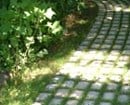
Alan Titchmarsh's December choice
‘The dormant season is an ideal time to add new plants to your garden, whether you're starting a border from scratch or filling gaps in an existing display. To help you choose the right plants, I've picked a few of my favourites that are looking their best right now. I've also thrown in a few timely tips on easy ways you can improve your garden'

Winter-interest climbers
This is one of my favourite winter wall shrubs with its cheerful yellow flowers appearing on bare, bright green stems throughout the winter and into early spring. It is easy to train on wires or a trellis, but looks just as attractive if left to scramble freely over low walls.
A real cutie, this scented winter clematis has creamy bell-like blooms that are heavily speckled inside with reddish-brown 'freckles'. It always reminds me of a bird's egg. Train it over a sunny pergola or arch where the distinctive markings of this evergreen climber can be seen to best advantage.
This superb variegated Persian ivy has heart-shaped, creamy yellow-splashed, mid-green leaves. As it matures the variegation of the foliage becomes more pronounced. It's an excellent plant for covering a shady wall or as fast-growing groundcover.
Shrubs for winter flowers
If vanilla is your thing, try this sweetly scented, pure white flowering sweet box. Blooming from December to March this wonderful dense, evergreen shrub is perfect for a shady border or woodland garden. Copes well with dry shade and urban-pollution.
Reliable and easy-to-grow , this lovely, long-flowering laurustinus is perfect for brightening partly shady areas when little else is in flower. The flattened heads of white winter blooms are followed by dark blue-black fruit.
Fabulously long catkins hang like giant silky tassels in January and February - adding much-needed interest to the winter garden. This hardy evergreen shrub has attractive leathery green leaves that provide a foliage backdrop to the seasonal displays of other plants at different times of the year.
Ever-colourful evergreens
One of the joys of early spring when it bears elegant clusters of tiny blooms that look like bunches of lily-of-the-valley. The flowers are joined by glossy, bright red young leaves that progressively turn pink, creamy white and then dark green. Needs an acid soil or can be grown in a pot filled with ericaceous compost.
I love this handsome evergreen that's guaranteed to brighten the winter garden. It's variegated foliage, with irregular yellow margins, looks good all year and is decorated by clusters of fragrant, red-purple flowers right now. Plant it at the front of a prominent sunny border to appreciate the intoxicating scent to the full.
Huge clusters of brilliant red berries from autumn to winter stand out on the almost spineless, glossy, dark green leaves and dark purple stem. This hardy English holly makes a handsome evergreen specimen tree for a small garden, providing an excellent source of food for birds.
Trees for small gardens
Who can resist the spectacular, bright white bark of this birch? It offers interest all year round with its dark green leaves turning buttery yellow in autumn, and masses of mustard-coloured catkins produced in spring. An elegant tree that can be grown as a specimen in the lawn, grown in a group in a woodland or just planted as a feature in the garden border. Medium to large.
This gorgeous deciduous tree has a lovely spreading habit and dark green leaves which turn yellow in autumn. Then, during mild spells in October through to March, the branches are smothered in soft pink blossom. A wonderful choice for the smaller garden and where space is limited. Eventual height 8m.
An early spring treasure that looks amazing when covered in golden male catkins from March onwards. It forms a dwarf, weeping tree that's suitable for the smallest garden and can even be grown in a pot on the patio. The early spring stems look superb in cut-flower arrangements, too.
Flowers all winter
Wonderful, often pink-flushed, white, bowl-shaped flowers from February to April and leathery, dark green leaves. The ever-popular Christmas rose used to be planted close to cottage doors to prevent evil spirits from crossing the threshold. Useful!
Simply stunning, this variety has large, saucer-shaped flowers from dark purple to almost blue-black during the coldest months. This Lenten rose is seed grown so many colour variations may occur. Given space, it will spread to make a lovely under-planting in dappled shade.
These diminutive cyclamen are perfect for naturalising around the base of deciduous trees and shrubs. Delicate pink or white flowers with upswept petals are blooming right now and will be produced in succession throughout the winter months above rounded, silvery-green leaves. A real gem!























